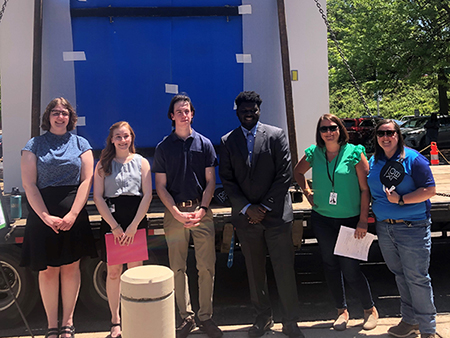For most UAB engineering students, Senior Design is a one-time thing. An arduous, two-semester team project, often referred to as the “capstone” of their undergraduate education.
For UAB alumnae Haley Ashway and Ashlyn Manzella, Ph.D., this year’s senior design course was a do-over, of sorts, as the two worked as mentors on a senior-design project to build a wall-racking system for BLOX, a local company that manufactures medical modules.
Ashway (ME, 2010) is a program manager at BLOX, a growing company that regularly recruits students from the School of Engineering. “I was trying to think of ways we could strengthen our network with current students, and one of the ideas we came up with was to sponsor a senior design team,” she said. “I reached out to Ashlyn, and she was able to get in touch with the right people in the school to make it happen.”
Manzella, a former BLOX employee, received her B.S., M.S., and Ph.D. from UAB in civil engineering. She currently works for the Birmingham Water Works Board and is a certified course instructor in the School of Engineering. She was able to get her in touch with the right personnel in the school—but before they could sponsor a team, they needed a project. Ashway worked with the BLOX research and development team to identify a current need in their manufacturing process. The result was a request to redesign the BLOX Wall-Racking System.
From the project description: “The Headwall Module is around 800 pounds and tops out at nine feet, four inches. This causes a condition when handling the unit to be very labor-intensive in both the manufacturing faciality and at the construction site. The “Headwall Rack” system needs a redesign effort for how the walls are loaded at the plant, transported to site and unloaded….There is an opportunity to evaluate the current design of the rack system to seek modifications that eliminate the safety and handling issues. There is also an opportunity for a full redesigned prototype that would satisfy the current internal and external customer requirements.”
The team of students that accepted the challenge consisted of Makaela Casper, Jared Gibson, Reed Hvarven, and Denzil Otali. Together, they designed a product and put it through various tests using computer modeling. Then, they worked along with the BLOX research and development team to manufacture and assemble a working prototype.
The finished product met the objectives of the assignment, and the assembly process and testing of the prototype revealed a few minor modifications that could improve the product for commercial use. In the end, Ashway says the project was a success for both BLOX and the students. “I hope we can get some of our younger team members to get involved with projects like this and we can do it on an annual basis,” she said.
